
Amongst the wide range of parking solutions that can contribute to reduce parking problems or regulate parking activities, e-Parking looks at developing and applying an innovative e-business application for parking optimization services.
Requirement:
The two target user groups of a Parking Brokerage Service are primary drivers on the one side and parking space suppliers regardless of their type on the other side. For the primary categories, the essential aspect that needs to be taken into account when specifying a travel-related service are the information needs of the users. In general, drivers, as other types of travelers, expect services that provide accurate and real-time information, meet their preferences and particular needs, and are available whilst being on the move. Parking suppliers expect services that are adaptable or complementary to their parking management policy, can help them to improve existing services or that can bring them the possibility to offer new ones to their customers, can optimize their parking management operations, and that are related to their parking location and the purpose of use of their customers. Based upon these considerations the essential requirements that have been extracted to respond to the user needs are summarized below.
Real-time information provision, which shall be precise and accessible by the users of the system, makes use of available communication infrastructure.
Ease of use characterized by a destination is driven service including Geographical Information Service (GIS) modules, which is fast and easy to operate, and that is customizable permitting the introduction of user preferences and the information about services related to the parking destination.
The parking space provider offers parking space available for reservation. This information is registered in the parking optimization database.
Users are able to access the parking optimization application via the internet for obtaining parking information or for making a reservation request. The reservation request is registered in the Parking space Optimization database.
Policy Dashboard has the policy list, which maintains the information about parking rules in the form of Accordion views.
Creating Policies for parking rules which are used to define the parking spaces, parking period, and parking rates.
Each Policy has one more rule which is differentiating various Parking levels of the parking lot users.
Parking availability (off-hours and on-hours) validation features for creating policies related to defining the parking rates.
The policy list has actionable functionalities like Edit, clone, delete the policies, and assigned various policy groups and assignment history for the required policies.
Generating Reports and Templates of the Parking groups for getting the information related to parking metrics, threshold levels, space filters such as vehicle types and form factors, reporting period, time filters, etc.
From the reports, we can get accurate information about the Parking groups like occupancy, vacancy, revenue, parking violations, and dwell time, etc. for the specified periods.
Reports and templates of the parking groups can be viewed by chart visuals like a line chart, Histogram chart, Pie chart, Heat chart, and tabular charts for a specific time period basis.
Reports and Templates can be Edit and download for further actionable requirements.

Case Study missing?
Start adding your own!
Register with your work email and create a new case study profile for your business.



